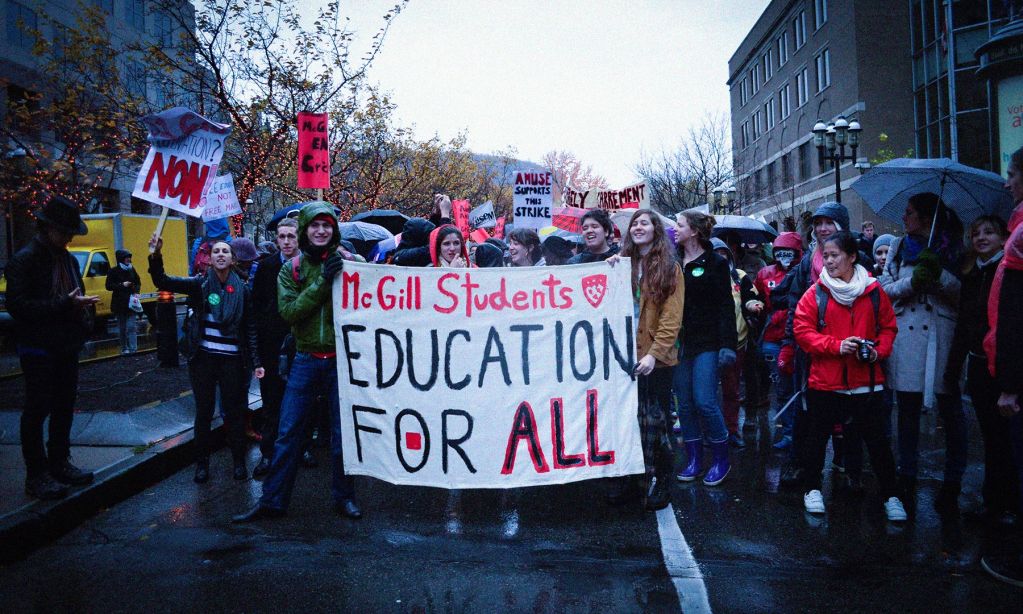When we’re talking about the cost of postsecondary education in Canada, student fees understandably take centre stage. But from the perspective of students,the true costs of post-secondary education are far greater. The cost of living is built into the cost of learning.
High fees, greater costs of living, and lost income while studying stack the deck against the students without enough family wealth to pay for higher education.
Student fees are usually the biggest up-front cost to students and their families, yet are only a small portion of the total cost of studying. According to estimates produced by the Canadian Student Financial Assistance Program (the main provider of student financial aid in Canada), four years of study from 2021 to 2024 would cost an average of $18,800 in fees after reductions by non-repayable grants, plus another $55,400 in other expenses such as textbooks, supplies, food, transportation, child care, and other living expenses.
That means student fees accounted for less than $3 out of every $10 of the average cost of undergraduate study. One has to keep eating and paying the bills while in school.
It is the indirect costs—mostly living expenses—that are the lion's share of the cost of post-secondary education—and those estimates were produced before the onset of the current inflation-driven cost of living crisis. The added costs of study are certainly even higher today.
Being a student can be very expensive
The issue isn’t just that students need to pay for living expenses on top of tuition, but that student life is often more expensive in general. While Canada lacks detailed data on the spending of post-secondary students found in some other jurisdictions, analysis of data from the Survey of Household Spending strongly suggests that students were spending much more on average to meet basic needs compared to non-students of the same age.
The economic pressure on students due to the cost of housing cannot be overstated. Rent was the greatest driver of higher living costs in 2019—consistent with recent research revealing that students pay an average of 25 per cent more on rent than the general population. As a result, post-secondary students experience housing distress at a higher rate than the general population. As many as 80,000 post-secondary students in Canada experienced homelessness at some point in 2019, often in disguised forms such as couch surfing. In 2022, the largest agency serving homeless youth in Toronto reported that about 13 per cent of shelter residents were university or college students.
Students also pay much higher food costs, which will come as no surprise to anyone who has dined on campus, where a small group of major multinational corporations dominate food services. Students eating on campus pay a premium to pad the profits of private food service providers. University-run food services are often no better, given the prevalent impulse among university management to cut costs at the expense of students. Students living on-campus are often forced to lock into very expensive meal plans that sometimes fail to cover food needs over a year.
This punishing combination of low incomes with high rents and food costs creates widespread poverty and hunger among students, which has been disturbingly normalized as an inevitable part of student life. Many students on shoestring budgets are forced to choose between paying tuition, risking eviction, or going hungry. Students cannot choose to pay a bit less rent for the month, but it is possible to put less food on the table. According to a survey of major Canadian universities in Fall of 2021, 56.8 per cent of students reported experiencing food insecurity, a rate over three times higher than the general population.
The financial pressure cooker of student life
On top of extra living costs, students only made less than half the incomes of non-students. This gap is almost entirely explained by income foregone by students because they can't work or work less during study. Only about four in ten full-time students are employed during the school year and all students are much more likely to work part-time, even during the summer months.
Due to much lower incomes, students are even more heavily burdened by the high cost of living. In 2019, the average student spent over 65 per cent of income just on food and shelter. Adding in other necessities like cell phones, personal care products, and transportation, students were spending over 125 percent of their average incomes just to cover the costs of living. While the average non-student under age 30 was not faring very well financially either, they spent a far lower share of income to meet basic needs.
When we incorporate the cost of student fees on top of food, rent and other necessary costs, we see that the cost of education is significantly higher than most students’ income. For the average student, out-of-pocket student fee expenses—that is, what they paid after bursaries, grants and scholarships—took up an additional 43 per cent of their income.
People in this situation are left with two options to cover the gap. If they’re lucky, they can receive gifts of money or in-kind—as is the case with students who are financially supported by their families to some degree. For those without that private safety net, the option is going into debt by taking student loans and racking up credit card debt. The chart below shows the difference in 2019 between household income and total current consumption, which means all spending before certain expenses like taxes, insurance payments, or gifts.
The average Canadian household enjoyed a modest income surplus that they could save or invest. Young people in general were going into debt by outspending their incomes, but students were racking up much more on average because their spending was higher, mostly due to higher rents and food costs, while their income was dramatically lower, because students lose out on working while in school.
We should not accept that student poverty due to high living costs and low incomes is a natural part of student life. Some countries provide targeted subsidies to students for food and housing. Going even beyond that, there are places on Earth where student poverty is greatly alleviated—and quality of life for young people greatly improved—by paying "student wages" paid to those in study.
It’s not that it’s impossible to achieve here—what’s missing is political will.







